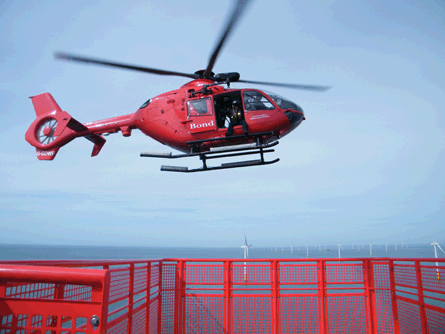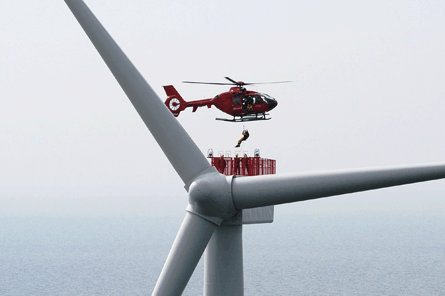Power generation capacity in excess of one gigawatt is offered by the 400-odd wind turbines dotted around the UK coastline. More than 600 new turbines - to supply a further 2GW-worth - are under construction, and as many again have received approval. However, thousands more are required to meet the UK target of renewable energy contributing 15% of Britain's energy needs by 2020.
The favoured areas for the UK's wind turbine clusters - based on prevailing winds and the nature of the sea bed - are the southern North Sea and off the northwest coast of England.
Offshore turbines are built up to three times the size of their land-based cousins. They all need maintenance, and those within test sites in the Thames Estuary are served by engineers ferried by boat. They jump from the launch on to a platform and climb up to the nacelle via a cage-elevator or, in extremis, an internal ladder.
 |
|---|
© Unifly |
But new sites are extending further offshore, and the number of days per year when the sea-swell is within limits - up to 1.5 metres - average fewer than a hundred. Simply put, the further offshore the fields stretch, the more attractive helicopter options become.
Denmark's "Horns Rev 1" was the first wind farm in Europe to be linked to shore by helicopter. The UK pioneer will be "Greater Gabbard" - a growing cluster of turbines already contributing energy to supplier National Grid from off the Suffolk coast. A Eurocopter EC135T2+ from Bond Aviation Services is poised to enter service from Lowestoft, equipped to transfer Southern and Scottish Energy (SSE) technicians by hoist to a maintenance platform on the turbine nacelle.
The aircraft is crewed by a pilot and helicopter hoist operator - a winchman for the 21st century - who will shuttle pairs of engineers between the shore and the 100-plus turbines that will eventually make up Greater Gabbard, and its "Galloper" extension. So far, about 40 are in position.
The initial plan is for the helicopter to fly out, drop passengers and fly back. It will be an operation in visual meteorological conditions, and compliant with CAP437 and CAP764 regulations originally drafted for offshore energy platforms. Public transport winching standards established for civil search-and-rescue training flights will also be in effect. The wind limitation will be 40kt (70km/h).
SINGLE-ENGINE PERFORMANCE
For maintenance periods, the turbine blades will be stopped by the SSE operations centre in Lowestoft, 90º out of the wind and in the optimal "bunny ears" position - with the stationary blades on the aircraft's starboard side. The helicopter will approach to a 15ft (5m) hover above the platform and lower the technicians from the winch on its starboard side, behind the pilot. Danish operator Unifly favours the port side.
The platforms were designed by the nacelle manufacturers and vary in size and layout from field to field. Future, larger (6MW) turbines may feature an aluminium helideck. In that case, helicopters will be able to carry larger payloads.
 |
|---|
© Bond Aviation Services |
From its base in Norwich, the Bond EC135 has been deployed on training exercises throughout 2011. For practice, the aircraft has flown either to a similarly-sized shipping container on the airfield or to the Gunfleet Sands cluster of Siemens turbines, off the Essex coast. Greater Gabbard is also to be equipped with turbines of this format.
Procedures for accessing faulty or stranded turbines are still being developed.
Bond director Paul Westaway says the EC135 will be suitable for servicing the next generation of turbine fields, from helipads built on the coast.
"Between twelve and 20 minutes flying time will put us in the middle of most of them," he says. "While boats will still be part of the equation, especially during the summer months, the quickest of them travels at around 30 knots. That's a quarter of the helicopter's speed, so we can make an economic case for minimising lost production."
The requirement for scheduled maintenance is as yet unknown, but Westaway says each turbine will require at least one full day a year. "Everyone is waiting to see how Greater Gabbard pans out," he added.
That revelation might take some time. The Bond helicopter and its crew have been ready to go for months now, but SSE is waiting for another tipping point - when the number of turbines or the deteriorating autumn weather make the helicopter the preferred option. Since this is a new field, nobody yet knows where that point is.
THE CASE FOR LARGER MACHINES
Greater Gabbard's 100-odd turbines will be linked to two substations, which reduce transmission losses by "stepping up" voltage during its journey to shore. On average, one substation is required for every 50 towers. As they are fitted with crew refuges and helidecks they could, with time, evolve into accommodation platforms.
As the construction process continues the distances involve will gradually increase. In later stages, minimum distances from shore of 65km (35nm) will not only preclude the use of boats but, given the absence of fuel at the farms, may demand the introduction of medium or even large transport helicopters, such as the EC225/AS332L or S-92A. In that event, since the maintenance requirement and weather restrictions remain the same, an EC135-sized craft could well end up being based on one of these platforms.
Now a sales manager with Eurocopter UK, pilot Ollie Dismore prepared the safety case for using helicopters as the map of offshore fields was being drawn up. "It won't be long before people will have to live offshore again," he says. "The game is avoiding unnecessary downtime and, to be economic, the turbines must rotate for at least 90% of the time. A [6MW] turbine unexpectedly out of action means the loss of £1,000 [$1,596]-worth of electricity per hour - equivalent to £24,000 a day.
"As this mounts up, the helicopter case becomes more attractive. Using a boat might also mean an uncomfortable two-hour journey, and even a climb up the tower ladder. Only some of them have lifts."
 |
|---|
© Bond Aviation Services |
On average, each turbine requires three maintenance visits every year and, when you can schedule a helicopter with some confidence - even during the winter - the case becomes increasingly persuasive. "Expecting a crew to make a two-hour boat ride, then to climb up the tower, carry out the maintenance and reverse the whole procedure is asking a lot during winter daylight hours," Dismore added.
Dismore estimates that by 2020, when as many as 6,800 turbines could be in position, they will require a similar number of technicians cycling through in support: "I can see the more remote fields featuring accommodation platforms or 'floatels' and crews working two-week shifts offshore. They will be taken there by a large transport, and a 135, say, will be stationed there to provide transfers. Once on-site, it will not be constrained by CAP437 restrictions - requiring external floats, ELT [emergency locator transmitter] and so on - so can shuttle between towers all day long.
"At night it would need some protection from the elements, but that needn't be a permanent structure. It only needs to come ashore every 400 hours for maintenance - so could be on site for as long as six months. While deployed it can fly underslung loads and drop them directly into the nacelle via a hatch on the platform. A crane and workboat represents, in my opinion, an unappealing alternative. We might even see a SAR [search and rescue] helicopter based offshore."
He adds: "The helicopter safety case is statistically similar to that for boat transfer, but the passengers would much rather fly. You launch with up to six passengers and lots of fuel, fly out to the furthest tower then work your way back. The time spent at each turbine depends on whether the engineers are doing routine maintenance or tracing a fault. At the furthest boundaries you may only be able to loiter in the vicinity for a few minutes, plus IFR [instrument flight rules] reserves, and there isn't much by way of diversions."
He predicts a requirement for 20 dedicated EC135-sized aircraft within the next 10 years, adding: "If 1,000 turbines need three visits per year, plus unscheduled maintenance, you're looking at 6,000 flights annually." But Paul Westaway believes that, even given this expansion, demand for helicopters will be less than during the North Sea oil and gas boom.
"The level of automation and, consequently, smaller crews will dictate a significantly different style and scale, both operationally and in terms of demand for our services," he says. "However, even if it delivers only 30 or 40% of that we enjoyed during the last energy bonanza, there will be good business for us."
Source: Flight International























